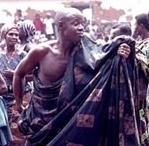Translations:
Other Pages:
Key Words
Modules
Sociology:
Home Page
Lecture Notes
Discussions
Hub
Utilities:
Site Map
Contact
Utility Documents
Useful Links
AKAN CASE STUDY
Matrilineal groups in West Africa
by Phil Bartle, PhD
Training Handout
An example of the wide variety of kin arrangements
Kwawu Elder:

|
Many countries have immigrants from hundreds of societies of origin. This is one of several factors contributing to a huge variety of family forms and functions in eacj country.
To demonstrate the variations in families, we look at the Akan societies of West Africa. See Canadian Immigration (Ghana).
While these notes originally refered to Canada as the host country, similar processes are occuring in other areas of immigration such as all of North America and Western Europe.
The word “family” is Latin in origin. It meant domestic slaves. There is no precise equivalent word in Akan. Family is not a universal institution. Social scientists once assumed that the nuclear family was at the central element or building block of all kin systems. Not so in matrilineal societies. In Akan society the nuclear family is not the building block: there is no word; no practice. Akan society has two words that are related. The word “abusua” is a corporate descent group, while the word “fifo” (literally house people) means a residential group. Akan people in Canada speaking English may talk about their "family" back home. They mean their "abusua."
What is a corporate descent group? It is like a corporation. Membership is by birth, and it has no affines (people related by marriage). In a matrilineal society, that means all members of the group belong because their mothers belong. Your spouse or your father can not belong to the same abusua as you.
The group has maybe 100 to 200 members (boundaries are not easy to determine). It is not a communal organisation; there is division of labour and inequality within it. The descent group may own land, offices, houses, and gods.
To help you understand the structure, take a personal view. Your father or spouse cannot belong, but your mother’s brother belongs. Your mother’s mother’s mother’s mother’s sister’s daughter’s daughter’s daughter’s son belongs. Your sister’s children belong.
Akan Kinship:

|
A student asked if Akan matriliny was like that in the Canadian West Coast First Nations (aboriginal) societies. West Coast First Nations are quite varied, with Tlingit and Tsimshian in the North, Haida on the West, Wakashan south of that, and Salish on the south coast. There is a range of mixtures from North to South, from matrilineal to patrilineal. Technically, the Akan have kin terms classed as "Iroquois" (as in southern Ontario from Montreal to Windsor). See Govt of BC (BC First Nations).
Matriliny is not matriarchy. The suffix, “liny” refers to descent, while the suffix “archy” means power. The Akan kin system is lineal, and it is not automatically one which confers power on women. Instead, we use the word “gynocracy” meaning that some power, wealth and independence is allocated to women. See my paper, Covert Gynocracy.” The women had status much more than those in western societies and patriarchal patrilineal ones. In East Africa, for example, women are submissive and oppressed in comparison to those in Akan societies. Matriarchy would imply that women are automatically the recognized leaders; that is found in no known and studied societies.
Covert means hidden. In Akan society the higher power, wealth and independence of women is not so evident. Formal recognition (prestige) of office is not common, except for a few female chiefs, elders and priestesses; women find it useful to keep this power hidden.
In a chief’s court, where perhaps nine out of ten of the elders are men, they may come to a difficult stage of their case, conflict resolution, or deliberation. They will break and then each head back to his or her matrilineal house (where the ancestral stools are kept) to "confer with the ancestors." It turns out that they are conferring with the older women in the matrilineage.
The matrilineal Akan spread and expanded, and took over earlier patrilineal Guan areas. Matriliny, based upon ranked confederations of matrilineages, is the basis for more effective organisation for war than is patriliny where the patrilineal corporate descent groups had no mechanism for confederating. Confederations were structured as in an army, with one lineage designated for each of four deployment positions, forward, left, right, and rear, plus interior affairs, and paramount. Like a football team or hockey team, each have different but complementary roles which make them stronger overall.
A high divorce rate is functional in all matrilineal societies. When members do not direct all their attention and efforts to their spouses, this supports strength of the abusua. Husbands and wives would live together temporarily, as when they were in satellite villages farming, or in cities and towns for employment or trade. Women had power, wealth, and independence (esp. from fathers and husbands), so they were not dependent upon staying in a nuclear family for financial security. Often members of the home town would return home, especially for funerals and for Easter. The common pattern was for husband and wife to go and stay in their separate ancestral, matrilineal homes for the duration of the visit, even if they lived together in their away residence. This is where a common practice was observed and noted in the literature, children going from Momma’s house to Daddy’s house every late afternoon carrying supper on their heads.
When a man had two or more wives, they would each stay in their separate lineage houses (a man could not marry two women from the same lineage, except that female twins became wives of chiefs). The man would inform which wife had a turn to spend the night with him. Although permitted, polygyny was and is quite rare, because most men could not afford to keep more than one wife. If a wife died, it was the responsibility of her matrilineage to provide a replacement. The relationship of marriage was the symbol of the confederation of the matrilineal oman structure. Each matrilineage was considered a wife of the chief’s lineage. When a chief died, and a new one was elected by the lineage, he inherited all assets and liabilities, including all the wives. For many of them this did not involve conjugal duties, but was a form of old age security. In the town of Obo, where I did my PhD research, the chief had over thirty “structural” wives, but in practice lived with only one wife, the woman he had married before he was selected as chief.
Swiss missionaries came to the Gold Coast in the mid 1800s. They introduced much more than the theology and ritual of Christianity. They sought nothing less than the complete transformation of Akan society into a system imitating that of their Swiss origins.
Their support for the ideal of a nuclear family implied that women should be obedient to their husbands, stay at home to do domestic chores and raise their children while their husbands went out to work, and to abolish chieftaincy, matrilineages, ancestors, gods and the other institutions which supported these ancient notions.
Christian social structure, where it was adopted, contributed to a decline in women’s status (though not as much as Moslem social structure).
Husband and wife residing together in the same residence, neolocal residence, is not a central element (building block) or Akan social structure. It does happen, and is correlated with whether the couple is in the home town or away. The system developed in the long past, when away meant living in the satellite villages to farm. When the couple returned to the home town, they would each go to stay in their separate lineage houses. With urbanization, and Akan people going to find work in the city, in the country towns, or overseas, the same pattern has been adapted. Husbands and wives live neolocally while away, but are likely to live duolocally when in the home town, temporarily for funerals, festivals and Easter, and permanently for retirement, especially if one of them succeeds to a stool office.
This pattern of duolocal residence in the home town and neolocal residence while away produces a household pattern that has been interpreted as social change that is more apparent than real, as if urban households represent the westernized pattern.
The verb “to marry” is used differently in the Akan language than it is used in English. The relationship can be temporarily discontinued if there is an annoyance between spouses, and the verb reflects this.
Senior women have huge power in running abusua (lineage) affairs. Much of this is not public. It is covert. Elders (9/10 male) in a chief’s court may break during a case to “consult the ancestors.” They each go off to their separate lineage houses, perhaps to have a meal. They consult the old women in the abusua (matrilineage) house. The facts are known to those old women, who keep better track of descent lines, and they influence the decision made in the chief’s court by advising the elders during that break.
Separation and divorce have high frequency –– especially after the child bearing and child raising years. This is seen as a needed element in maintaining the abusua (lineage). A high divorce rate is common among most matrilineal societies around the world.
Immigrants have their feet in two cultures. This has particular significance for Akan migrants to Canada. As with most immigrants, Akan people in Canada retain their links to home, especially to their abusua. Since neolocal residence is part of their original matrilineal social structure, they look like they have assimilated, and adopted the mainstream Canadian model of neolocal residence.
As increasing numbers of immigrants come from societies with different structures and functions than mainstream Canada, our society is becoming increasingly heterogeneous. Students now contemplating professional careers, for which they are now studying criminology, social work, early childhood education, and any other which may require interventions or communications with people from many cultures, it is useful to look at the Akan system for an idea of just how different a family pattern may be while sometimes appearing to be more similar than it is.
See my more technical essays, Covert Gynocracy, and Three Souls.